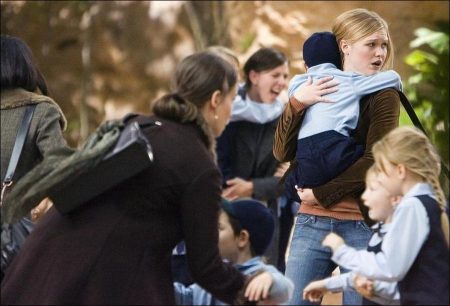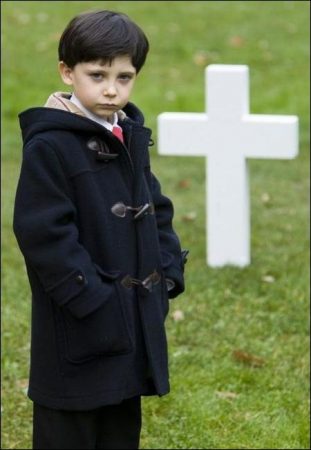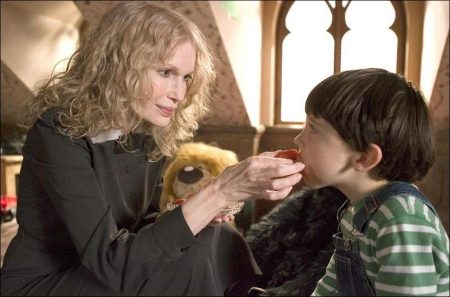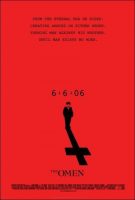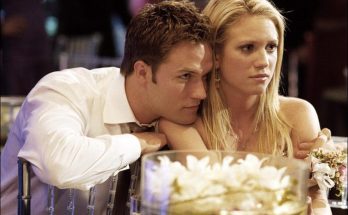Tagline: The prophecy is clear. The signs unmistakable. On the 6th day of the 6th month in the year 2006 his day will come.
The Omen movie storyline. The prophecy is clear, the signs unmistakable: Armageddon is upon us. On 6 / 6 / 06, the omen is revealed…and our darkest fears are realized. THE OMEN, a contemporary thriller based on the 1976 classic film, centers around a young boy named Damien, the son of an American diplomat and his wife. Damien’s family is unaware he is destined to become the Anti-Christ – until shattering events reveal the terrifying truth.
Fear the date – 6/6/06 – when “The Omen 666 opens in theaters nationwide. A remake of the 1976 horror classic, the new film takes the tale of the coming of the antichrist – personified as a young boy named Damien – to an even more thrilling and visceral level.
“…From the Eternal Sea he rises
Creating armies on either side
Turning man against his brother
`Til man exists no more”
Many believe the prophecy from the Book of Revelation provides a map to a terrifying future… or it presents fragments of history that have come to life in our time. The signs, they claim, are all around us: terrorist attacks, extreme weather… the list goes on.
The passage specifically points to the arrival of the Anti-Christ, who is branded with the numerical sequence “666”: the mark of the Beast. The Anti-Christ will receive his power directly from Satan to establish a counterfeit kingdom on earth, signaling the beginning of Armageddon…
Robert Thorn is unaware of such dark prophecies. Thorn, a senior American diplomat, has other things on his mind. His wife, Katherine, has endured a difficult delivery and she’s as yet unaware their newborn child has died. Devastated by the loss, Thorn’s concern turns to Katherine, who had suffered two previous miscarriages. The news will surely devastate her.
The hospital priest, Father Spiletto, presents Thorn with another child born that night, whose mother died in childbirth. The priest compels Thorn to take the infant boy as his own; Katherine will never know the truth, and their son, which they name Damien, will be raised as their flesh and blood. Katherine embraces the child as her own, blossoming in motherhood; Thorn, it would seem, has made the right choice.
Thorn’s career ascends — he becomes the U.S. ambassador to Great Britain — and the family settles into an estate outside London. But certain events, all seeming to revolve around the now five-year-old Damien, are deeply disturbing: Damien’s nanny hangs herself at the youngster’s birthday party; a strange priest brings dire warnings to Thorn; a children’s trip to the zoo results in a panicked frenzy; Damien becomes hysterical during a drive to church; and blurred movements in a series of photographs portend shocking deaths.
The prophecy is clear, the signs unmistakable: Armageddon is upon us. On 6 / 6 / 06, the omen is revealed…and our darkest fears are realized.
THE OMEN is a contemporary thriller based on the 1976 classic film released by Twentieth Century Fox, starring Gregory Peck and Lee Remick, and directed by Richard Donner. The film, like “The Exorcist” and “Rosemary’s Baby” before it, galvanized audiences not only through its shocks and scares, but through the filmmakers’ storytelling gifts and its top-flight cast. “The Omen” became one of the biggest hits of the year.
Director John Moore counts himself as one of the film’s many admirers. He also had come to realize that “The Omen’s” exploration of evil is now more relevant than ever, and he was eager to take the reins of a new version of the story.
“There has never been a more salient time to remind people that evil is neither a concept nor a theory,” Moore says. “It has a human face and it empowers itself through human actions. The true nature of evil has never been more apparent.
“In just the past four years alone,” Moore continues, “the world has been hit with devastating events — political, natural and man-made. One can’t help but notice a certain momentum.”
THE OMEN retains much of the structure and themes of David Seltzer’s 1976 screenplay, but there are several important changes to update the story and characters. “The original film had a strong foundation,” Moore states. “But there were several opportunities to give the characters a more contemporary feel.”
In the 1976 “The Omen,” Robert and Katherine Thorn are a comfortable middle-aged couple, with Robert having had a long and distinguished career in government service. In the new film, they’re significantly younger. Producer Glenn Williamson notes: “We felt that by making Robert and Katherine younger, they’d project the image of a couple on the ascendancy of their lives, both personally and professionally. While they’re educated and successful, they’re also young and working hard to make their career and marriage work. It adds to their confusion and shock when they begin to suspect, and then discover the truth about Damien.”
“These are complex people, real people,” adds John Moore. “By making the characters more accessible, the audience must consider, `If a man this strong and relatable can fall, then it could happen to anyone.'”
Early in the story, Robert makes a decision, purely out of love for his wife, which proves to be ruinous. John Moore says: “The film asks the questions: What would you do if you truly loved somebody? What would you do to make them happy? And what Thorn does — protect his wife from the devastation of a child lost at birth — is seemingly benign. People adopt children; it happens all the time. But from this `innocent’ lie and his attempts to do some good, that evil is able to come into his life and into the world. “It’s a tragedy on an intimate scale, in how it affects his family,” Moore continues. “On a global level, Robert has opened a doorway to evil because he has, without realizing it, shaken hands with the devil.”
About the Production
Through his early commercial work and two previous motion pictures, “Behind Enemy Lines” and “Flight of the Phoenix,” John Moore is known for his distinct visual style, which is fully realized in THE OMEN. Moore, together with his collaborators, turns even the most innocent event, like a sunny child’s birthday party complete with clowns, carousel and puppets, into a nightmarish ordeal. A Sunday morning visit to church leads to an inexplicable burst of hysteria. And a child’s ride on a scooter puts his parents on a very dark path.
To help create the mounting thrills, Moore and director of photography Jonathan Sela conduct a careful balance of light and shadow. “THE OMEN, photographically, is about light and dark,” Moore explains. “And within every frame there’s a struggle for light to win out over darkness.”
Moore employed the latest in film technology to convey certain themes and actions. For a key scene where Katherine is pushed over a balcony, Moore and Sela used a camera mounted with a Libra head, which can sustain and “absorb” movements. The special equipment gave an almost otherworldly “smoothness” to Katherine’s descent. Glenn Williamson explains: “The rig was created so the camera was mounted just over Julia, with the apparatus rappelling as she’s falling. It’s almost like a demon chasing her down.”
Through his filmmaking magic, Moore gives a poetic feel to the horrifying proceedings: The alabaster and blonde Katherine, swathed in a creamy wrap, falls to the ground surrounded by a fluttering of blood red petals. “I was inspired by the imagery of Gabriel and the fallen angel,” Moore explains. “[Costume designer] George Little and I gave Katherine a shawl, which as she falls, makes it look like she has wings.”
With the camera positioned so close to its subject, a stunt double could not be used. So Stiles had to take the plunge…literally. Faced with the formidable stunt, Stiles said, boldly, “Okay, bring it on.”
Stiles’s initial bravura was soon replaced by reasonable trepidation. “I woke up in a panic in the middle of the shooting, thinking, `Oh, my God, they scheduled the stunt for my last day of shooting; what are they trying to pull?'” the actress laughs. “Then I panicked.” When the stunt coordinators showed her the rigging — and the scene was rescheduled to an earlier date, Stiles’s fears were assuaged.
For the stunt, Stiles spent three days in a harness. Toward the end, the actress admits, a little paranoia crept back in. “They had me hanging above the floor for quite a while. There was a safety lock on the rig, and two stunt guys were holding me up for three days. I could feel the tension of the rope, and them straining a little bit. I looked down and thought, `What if the stunt people get really tired? Or they have a muscle spasm?” As expected, the stunt went off without a hitch.
Schreiber also performed several of his own stunts, fighting off crazed dogs, spinning cars in the rain, and battling with Mia Farrow while carrying in his arms a kicking and screaming Seamus Davey-Fitzpatrick, emoting as Damien.
Audiences will see real fear in Schreiber’s face during a scene set at a cemetery, where Thorn and Jennings are attacked by ferocious dogs. Months before the scene was shot, Schreiber was introduced to a sweet female Rottweiler, which he thought was going to be his sparring partner for the scene. Much to his consternation, Schreiber arrived at the set to find a different dog. “He was male, much larger — and he hated me,” Schreiber recalls.
“The idea was to have the dog bite my arm, which would be padded, and see how it looked on camera,” Schreiber continues. Unfortunately, the dog continued to pull at the actor’s appendage longer than anticipated. The force of the dog’s body against Schreiber, who was backed up against iron fencing, not only knocked the wind out of the actor, but also cracked a rib.
Mia Farrow, too, found herself in the thick of the action. For a key scene near the story’s end, set late at night in a rainstorm, she had to, rather viciously, take a croquet mallet to the windshield of a car driven by Schreiber. “I think most actors will tell you the physical stuff is fun,” says Farrow. “It’s more like game playing.”
During a Thorn-Baylock fight scene, Schreiber accidentally kicked Farrow in the face as she grabbed his leg. Despite the minor mishap (Farrow wasn’t injured), Moore was pleased with the take, which was printed. Unfortunately, we’ll never see that take due to a technical glitch, the nature of which was never solved.
This was only one of several mysterious happenings that befell the production. Another unexplained phenomenon occurred when visual effects supervisor Matt Johnson was measuring a special shot with crows in the background — and his meter read…666. Johnson made a careful examination of the measuring device — because he had never before come up with this reading.
One night, during the filming of a scene where Thorn picks up a phone to speak with another character, one of the lights above the set exploded while the camera was rolling. If it weren’t for a silk diffusion positioned just under the light, the shattered glass would have fallen onto the camera crew.
On October 6th (there’s that number, again), nearly one-half of the cast and crew came down with a mysterious — and fortunately, mild — form of food poisoning. The food was later tested, but no bacteria were found.
Perhaps the spookiest on-set moments camewhen still photographer Vince Valitutti developed a series of photographs. Valitutti discovered that some images of Pete Postlethwaite as Father Brennan were imprinted with blurred movements streaking downward, like a javelin. Valitutti and the rest of the crew immediately drew parallels to the story, in which Jennings’s photographs of Brennan reveal the same blurred movements, which foreshadow a brutal end for the character.
THE OMEN was filmed mostly in Prague. “Our story has a European feel and Prague was perfect for our needs,” says executive producer Jeffrey Stott when discussing how production came to decide on shooting in the Czech Republic.
Production had more than three weeks of stage work scheduled, but much of the shooting was completed at practical locations. The film’s locales provided a taste of Czech history.
THE OMEN begins deep in the halls of the Vatican, which production staged at Prague’s Troja Palace’s Grand Hall. The Grand Hall provides an ideal setting for the scene, which announces the birth of the anti-Christ.
The story then moves to the Pope’s private chambers, which the production found at the library of the Strahov Monastery. Home to 1200 years of Czech history, the library had never before been used by a major motion picture production. Founded in 1140 by an austere and scholarly religious order, the library is one of the finest in Bohemia, boasting more than 125,000 volumes. Its ceiling fresco depicting the Struggle of Mankind to Know Real History by Franz Maulbertsch, was appropriate to the scene and story.
The company moved to Lednice for a week of shooting interiors and exteriors of the Thorns’ private residence. With its neo-Gothic style interiors, the Lednice Chateau is one of the finest examples of High Romanticism in the Czech Republic. Situated at Lednice Park, the land was acquired by the Liechtenstein family in the middle of the 13th century. In 1666 Karl Eusebius of Liechtenstein had an Early Baroque residence constructed as well as an Orangerie and formal gardens. It was in these very gardens that Damien’s birthday party and the subsequent suicide of his nanny was staged.
Two different locations worked seamlessly together for a scene where Thorn has a final terse meeting with Father Brennan. The first portion of the scene takes place under the Charles Bridge, Prague’s most celebrated structure. The bridge’s beautifully aged sandstone blocks and elegant archways helped create a visually dramatic effect for the scene.
The film’s climactic scene was to be completed at a location 45 miles east of Prague, at a church in the town of Kutna Hora. However, a few days before shooting was to commence, production designer Patrick Lumb found the site’s interior had been covered in scaffolding.
Lumb and his team scurried to find another suitable location. They found it at a private church in the town of Kladbury, situated an hour outside Prague and said to be the largest cathedral in the Czech Republic.
Prague’s ancient Vysehrad stood in for Jerusalem, where Thorn and Jennings meet Bugenhagen in an ancient underground labyrinth — and learn the truth about Damien.
The Omen (2006)
Directed by: John Moore
Starring: Julia Stiles, Liev Schreiber, Mia Farrow, David Thewlis, Pete Postlethwaite, Michael Gambon, Giovanni Lombardo Radice, Marshall Cupp, Rafael Sallas, Martin Hindy
Screenplay by: David Seltzer
Production Design by: Patrick Lumb
Cinematography by: Jonathan Sela
Film Editing by: Dan Zimmerman
Costume Design by: George L. Little
Set Decoration by: Paki Smith
Art Direction by: Katerina Kopicová, Martin Kurel, Laura Pozzaglio
Music by: Marco Beltrami
MPAA Rating: R for disturbing violent content, graphic images and language.
Distributed by: 20th Century Fox
Release Date: June 6, 2006
Views: 57

